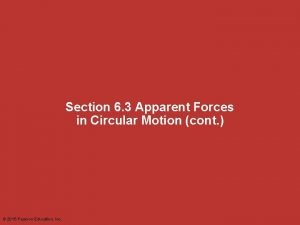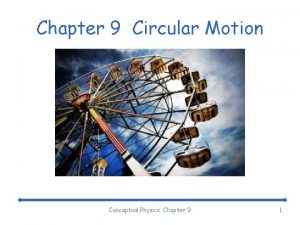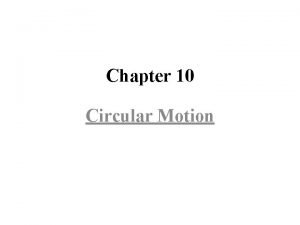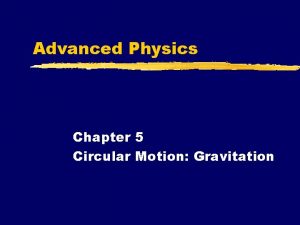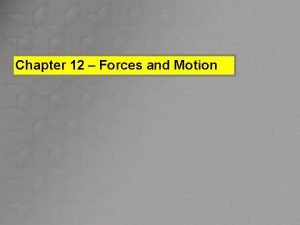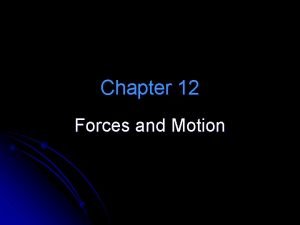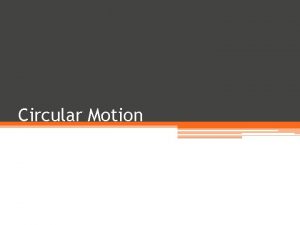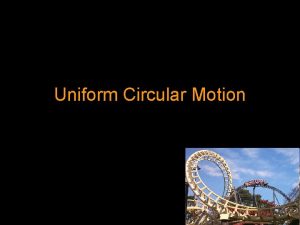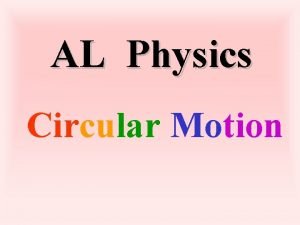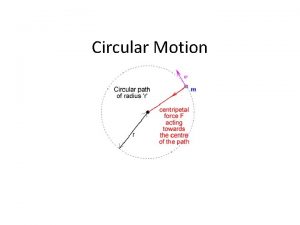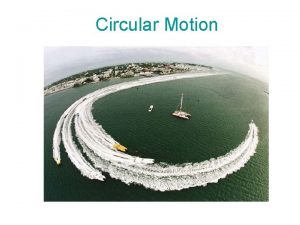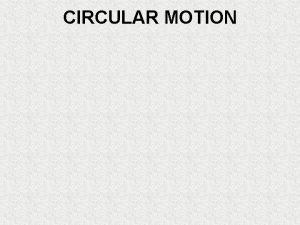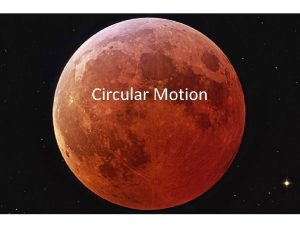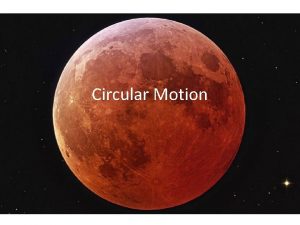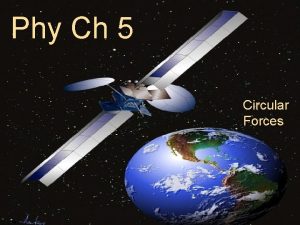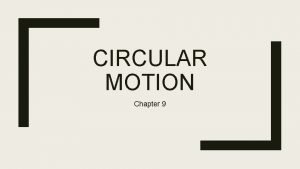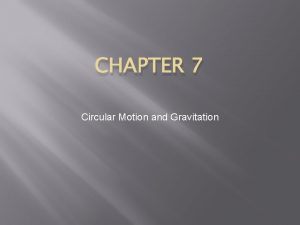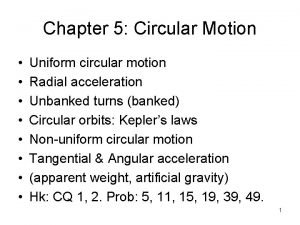Circular Motion Chapter 7 3 Motion Forces What

















- Slides: 17

Circular Motion Chapter 7. 3

Motion & Forces • What you already know: – Velocity – a measure of the change in distance over time with direction. – Mass – A measure of the amount of matter an object contains. – Acceleration – A measure of the change in velocity over change in time. – Force – A push or pull that is equal to the mass of the object multiplied by its acceleration (F = ma).

Uniform Circular Motion • Uniform circular motion is defined by any object that is moving at constant speed in a circular path. – Determining Speed: » The distance an object moving in a circular path is equal to the circumference (C = 2 r). » The time it takes an object to complete one revolution is called the period (T). » It then follows that the speed of an object moving in a circular path can be determined by: v = d/t = C/T = 2 r/T

Example #1: • A 1500 kg racecar takes 1 minute to complete one lap of a circular racetrack with a radius of 400. meters. – Determine the speed of the racecar.

Uniform Circular Motion • If an object is moving at constant speed in a circular path, can it be accelerating? – Yes » Although the speed may be constant, the direction is changing. » If direction is changing over time, then the velocity must be changing. » Acceleration is the change in velocity over time (a = v/ t). » If the velocity is changing over time, then the object must be accelerating. v v

Circular Motion – Instantaneous Velocity • Note that the velocity vector is at right angles to the position vector and tangent to the circle at any given point along the circle. v 2 r 1 r 2 r 1 r v 1 v = r/ t

Circular Motion – Centripetal Acceleration (ac) • The acceleration of an object moving in a circular path always points towards the center of the circle, and is perpendicular to the velocity vector. v 2 -v 1 v 2 v a r v 1 v a = v/ t

Centripetal Acceleration • The angle between r 1 and r 2 is the same as the angle between v 1 and v 2. – Therefore, the triangles these vectors make are similar such that: r/r = v/v – If you divide both sides by t: r/( t r) = v/( t·v) – Where : » r/ t = v and v/ t = a – Hence: v/r = a/v and ac = v 2/r

Centripetal Acceleration • An alternative representation for centripetal acceleration can be derived using the circumference and period of revolution. » d = 2πr » v = d/T = 2πr/T – Substituting into ac = v 2/r » ac = (2πr/T)2/r » ac = 4π2 r/T 2

Circular Motion – Centripetal Force • To make an object move in a circular path, an external force must act perpendicular or at right angles to its direction of motion. • This force is called centripetal force. Instantaneous direction of velocity Direction of force required to make object move in a circular path (towards the center)

Centripetal Force • Centripetal force is affected by: – The mass of the object (m). – The speed of the object around the circle (v). – The radius of the circle (r). • Using Newton’s 2 nd Law of Motion (Fc = mac), centripetal force is mathematically represented as follows: Fc Note: Centripetal force is an unbalanced “net” force

How the Factors Affect Centripetal Motion • Which graph shows the proper relationship with respect to force: – Force vs. Mass. Speed – Force vs. Speed. Radius – Force vs. Radius. Mass

Objects that travel in circular paths. What is the cause of the force? • The Earth – Sun System: – Gravity. • A racecar traveling around a turn on the racetrack: – Friction. • An athlete throwing the hammer: – Tension in the cable attached to the hammer.

The path of objects. • If the centripetal force were suddenly removed from an object moving in a circular path, what trajectory (or path) would it follow?

Which Path? Why? • Because of Inertia – An object in motion wants to remain in motion at constant speed in a straight line. • If the unbalanced centripetal force is removed, the object will continue in a straight path. (a) (b) (c)

Example #2: • A 1. 5 kg cart moves in a circular path of 1. 3 meter radius at a constant speed of 2. 0 m/s. – Determine the magnitude of the centripetal acceleration. – Determine the magnitude of the centripetal force. – Determine the period.

Example #2: (cont. ) • Centripetal Acceleration: ac = v 2/r = (2. 0 m/s)2/(1. 3 m) = 3. 1 m/s 2 • Centripetal Force: Fc = mac = (1. 5 kg)(3. 1 m/s 2) = 4. 6 N • Period: T = C/v = 2 r/v = 2 (1. 3 m)/(2. 0 m/s) = 4. 08 s
 Apparent forces in circular motion
Apparent forces in circular motion Chapter 9 circular motion answers
Chapter 9 circular motion answers Chapter 10 circular motion
Chapter 10 circular motion Chapter 5 circular motion gravitation
Chapter 5 circular motion gravitation Repeating lines in a hairstyle.
Repeating lines in a hairstyle. Laws of motion
Laws of motion Chapter 12 forces and motion
Chapter 12 forces and motion Forces are parallel
Forces are parallel The forces shown above are
The forces shown above are Intermolecular forces vs intramolecular forces
Intermolecular forces vs intramolecular forces Difference between intermolecular and intramolecular
Difference between intermolecular and intramolecular Covalent bond intermolecular forces
Covalent bond intermolecular forces Force and motion
Force and motion Balanced forces and unbalanced forces venn diagram
Balanced forces and unbalanced forces venn diagram What is constructive force
What is constructive force Chapter 2 motion section 1 describing motion answer key
Chapter 2 motion section 1 describing motion answer key What is acceleration
What is acceleration Section 1 describing motion worksheet answer key
Section 1 describing motion worksheet answer key
